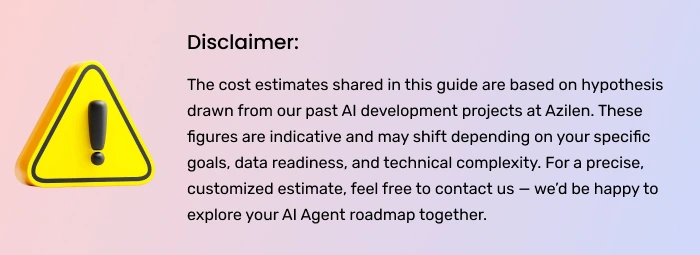
How Much Does it Really Cost to Implement AI in Healthcare?

The True Cost of Implementing AI in Healthcare
There’s no single number. But there is a pattern.
Most healthcare AI projects follow a few common tracks, from chatbot pilots to full-scale diagnostics. The implementation cost of AI depends on what you’re solving, how ready your systems are, and how much integration and compliance is involved.
Here’s a simplified breakdown based on real-world projects, including what’s usually involved at each level:
| AI Chatbot (Triage / Patient FAQ) | Clinics, Telehealth Startups | $10K–$50K | Pre-trained chatbot setup, medical content tuning, web/app integration, data privacy controls |
| Workflow Automation (e.g. claims, intake, scheduling) | Mid-size hospitals, group practices | $50K–$120K | Task automation engine, integration to HIS/ERP, internal user testing, SOP redesign |
| Medical Imaging AI (e.g. X-ray / CT analysis) | Diagnostics labs, hospitals | $100K–$300K | Imaging dataset prep, model selection or tuning, workflow integration, validation & explainability |
| Predictive Analytics (e.g. readmission risk) | Health systems, payers | $100K–$250K | EMR data modeling, risk scoring engine, staff-facing dashboards, compliance checks |
| AI Virtual Assistant (voice or multi-language text) | Chronic care platforms, remote care teams | $80K–$200K | NLP model setup, patient communication logic, escalation paths, privacy controls |
| Enterprise AI Platform (multi-department + EMR integration) | Hospital networks, HealthTech ISVs | $200K+ | Custom architecture, multi-model orchestration, live data sync, compliance layer, ops support |
If you’re just exploring or have a limited budget, you don’t need to jump straight to an enterprise platform. Many of our clients start with a $50K–$100K pilot, learn from it, and scale in phases.
And if you’re ready to explore AI more deeply, we can walk through your requirements and show what a right-sized investment looks like
Not Sure Where You Fit in This Cost Range?
We’ll help you break it down based on your goals, data, and systems.
What Factors Affect the Cost of AI in Healthcare?
Whether you’re planning a chatbot or a full-scale diagnostics engine, these are the real cost factors behind AI in healthcare:
1. Your Data Readiness
Do you have structured, clean, and labeled medical data? If not, be ready to spend time and money preparing it.
Data preparation often takes up to 20–40% of the AI budget.
2. Buy vs Build Decision
Pre-trained AI tools for medical imaging exist. But if your use case is niche or sensitive, you may need to custom-build.
Custom = higher upfront cost, but offers long-term flexibility.
3. Integration Needs
If you need AI integration with EMR, PACS, or other systems, it adds effort. This is where most underestimations happen.
4. Compliance & Validation
HIPAA, GDPR, MDR, and FDA guidelines require audit trails, testing, and sometimes external approvals.
5. Ongoing Ops & Monitoring
After launch, you’ll need monitoring, retraining, updates, and privacy upkeep. This adds 10–20% yearly to your total AI cost.
How Much Does AI Cost Per Month in Healthcare?
Here’s a simple breakdown of monthly operating costs of AI – based on low-to-moderate usage, like what most hospitals and HealthTech teams experience in early phases.
Monthly AI Cost Estimates by Use Case
| Chatbot for Patient Support | $1,500 – $3,000 | ~1,000–3,000 messages | Appointment FAQs, basic triage bot |
| AI for Radiology (X-ray, CT) | $5,000 – $10,000 | ~1,000–2,000 scans | AI-assisted image screening |
| Predictive Analytics for Readmission Risk | $3,000 – $6,000 | ~3,000–5,000 patient records | EMR-integrated alerts |
| AI Workflow Automation (Billing, Scheduling) | $2,000 – $4,000 | Based on task runs | Task routing, claims validation |
| EMR-integrated Multi-Department AI | $12,000 – $25,000 | Multiple departments | Diagnostics + operations + support AI |
What are You Paying for Monthly?
Healthcare-grade AI comes with recurring costs tied to safety, speed, and compliance.
Here’s a clear view of what’s behind those monthly bills:
1. Inference Compute Power (30–40%)
This is the engine that runs the AI model each time it analyzes data.
➜ For imaging AI, running models on GPUs can cost $0.50–$2 per scan
➜ For chatbots, $0.003–$0.01 per message on GPT-class APIs
2. Cloud Infrastructure (20–30%)
This is the engine that runs the AI model each time it analyzes data.
➜ For imaging AI, running models on GPUs can cost $0.50–$2 per scan
➜ For chatbots, $0.003–$0.01 per message on GPT-class APIs
3. Compliance, Monitoring & Audit Trail (10–15%)
In healthcare, this is non-negotiable.
➜ Model performance tracking tools like EvidentlyAI or Azure Monitor
➜ Role-based access control (RBAC), HIPAA/GDPR audit logs
➜ Risk mitigation frameworks (bias detection, drift alerts)
4. Support & Vendor SLA (15–25%)
Whether it’s internal or outsourced, someone has to keep the system healthy.
It includes technical support, issue resolution, model improvements, and SLA-based availability (especially for 24/7 services).
5. Model Retraining & Version Updates (Optional but Critical)
Your AI model needs tuning as medical data patterns shift. Most hospitals retrain every 3–6 months.
Amortized monthly, retraining adds about $1,000–$3,000/month to keep accuracy high and reduce clinical risk.
The Real Value Behind the Monthly Cost of AI in Healthcare
You’re not just paying to “run AI.” You’re paying for:
✔️ Faster diagnosis → Quicker treatment
✔️ Operational efficiency → Fewer bottlenecks
✔️ Staff support → Less burnout and turnover
✔️ Clinical quality → Fewer missed cases, better outcomes
In most real-world deployments, hospitals see ROI kick in within 12–24 months, with cost reductions and care improvements that far outweigh the monthly investment.
What Drives AI Costs Higher than Expected?
AI in healthcare can quietly become expensive, not because of the tech itself, but because of missteps during planning and execution.
Here’s what to keep an eye on:
➜ If your data isn’t already structured and labeled, your team might spend months just getting the data AI-ready.
➜ Over-customizing too early can affect your entire budget.
➜ Custom integrations can drain time and money if not planned properly.
➜ Delays in getting clearance or audit-ready documentation can slow you down and increase costs.
➜ If you don’t retrain or monitor the model regularly, its performance drops and fixing it later is more expensive.
➜ If you skip the human side (training, change management, or onboarding) the adoption suffers, and ROI stalls.
How to Budget Smarter (Even If You’re New to AI)?
If you’re exploring AI for the first time, it can feel overwhelming. But budgeting doesn’t need to be complicated. Here’s how to think about it in a simple, practical way:
Want to Estimate Your AI Budget in Minutes?
Get clarity on cost, timeline, and the right starting point.

You Don’t Need to Do it All at Once
AI in healthcare isn’t one big investment, it’s a series of smart, well-paced decisions.
Start with a narrow, high-impact use case. Work with the data you already have. Involve clinical, operations, and tech teams early. Plan for compliance and long-term upkeep.
The cost of implementing AI in healthcare becomes manageable when you’re not guessing – when you have a structured roadmap, the right tools, and a partner who understands both technology and healthcare workflows.
Ready to Explore Your AI Roadmap in Healthcare?
Let’s start with a quick discovery call.
Top FAQs on the Cost of Implementing AI in Healthcare
1. Is AI in healthcare a one-time investment or ongoing cost?
AI in healthcare is a continuous investment. While initial setup includes development and integration, ongoing costs come from:
➜ Inference compute
➜ Cloud infrastructure
➜ Model retraining
➜ SLA-based support
➜ Compliance monitoring
2. How do data and integration affect AI implementation costs?
If your healthcare data is unstructured, scattered, or unlabeled, expect up to 40% of your AI budget to go into data prep. Integrating with EMR or imaging systems adds complexity and hidden costs. Planning early reduces delays and overspend.
3. Can small clinics afford AI in healthcare?
Yes. Many clinics start with low-cost AI tools like triage chatbots or appointment automation, which typically cost $10K–$50K. These projects often serve as pilots before scaling.
4. Should I build my healthcare AI solution or buy one?
It depends:
➜ Buy if your need is standard (e.g., a chatbot).
➜ Build if your workflows are unique or require deep integration.
Azilen helps you evaluate both paths to find the right balance of cost, flexibility, and speed.
5. What are hidden costs in AI implementation in healthcare?
Watch out for:
➜ Time-consuming data prep
➜ Unplanned compliance audits
➜ Over-customization
➜ Unaccounted integration effort
➜ Lack of post-launch support
These can inflate budgets and delay ROI if not planned properly.
Glossary
1️⃣ AI in Healthcare: Use of artificial intelligence technologies to improve clinical, operational, and administrative healthcare functions.
2️⃣ Medical Imaging AI: AI systems that analyze medical images (X-ray, CT, MRI) to support or automate diagnoses.
3️⃣ Predictive Analytics in Healthcare: AI models that use patient and clinical data to forecast outcomes like readmissions or disease progression.
4️⃣ EMR Integration: The process of connecting AI solutions to Electronic Medical Records systems for data access and clinical workflow automation.
5️⃣ HIPAA Compliance for AI: Ensuring AI systems meet U.S. healthcare privacy and security standards under the Health Insurance Portability and Accountability Act.



 10 mins
10 mins











 Talk to Our
Consultants
Talk to Our
Consultants Chat with
Our Experts
Chat with
Our Experts Write us
an Email
Write us
an Email





